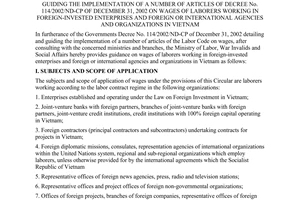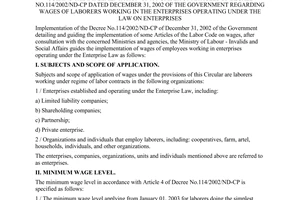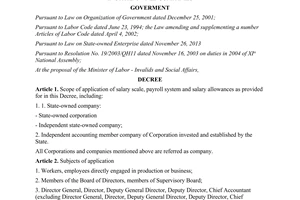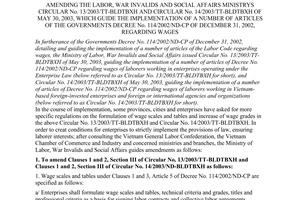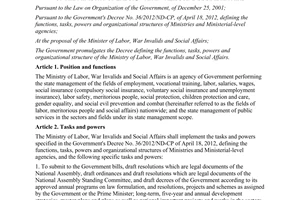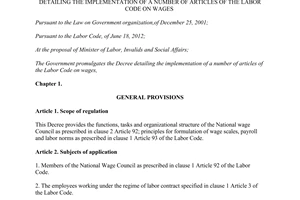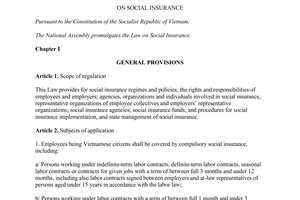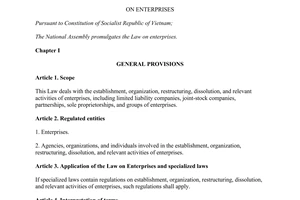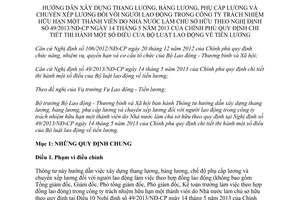Nội dung toàn văn Circular No. 17/2015/TT-BLDTBXH formulation salary grading employees limited Liability companies
|
MINISTRY OF
LABOR - INVALIDS AND SOCIAL AFFAIRS |
SOCIALIST
REPUBLIC OF VIETNAM |
|
No.: 17/2015/TT-BLDTBXH |
Hanoi, 22 April 2015 |
CIRCULAR
GUIDING THE FORMULATION OF SALARY SCALE, SALARY TABLE, SALARY ALLOWANCE AND SALARY CHANGE AND GRADING FOR EMPLOYEES IN ONE MEMBER LIMITED LIABILITY COMPANIES OWNED BY THE STATE UNDER DECREE NO. 49/2013/ND-CP DATED 14 MAY 2013 OF THE GOVERNMENT DETAILING THE IMPLEMENTATION OF SOME ARTICLES OF LABOR CODE ON SALARY
Pursuant to Decree No. 106/2012 / ND-CP dated 20 December, 2012 of the Government regulating the functions, tasks, powers and organizational structure of the Ministry of Labor - Invalids and Social Affairs;
Pursuant to Decree No. 49/2013 / ND-CP dated 14 May, 2013 of the Government detailing the implementation of some articles of the Labor Code on salary;
At the request of Director of Labor – Salary Department
The Minister of Labor - Invalids and Social Affairs issues the Circular guiding the formulation of salary scale, salary table, salary allowance and salary change and grading for employees in one member limited liability company owned by the state under decree no. 49/2013/ND-CP dated 14 May 2013 of the Government detailing the implementation of some articles of labor code on salary.
Section 1: GENERAL PROVISIONS
Article 1. Scope of regulation
This Circular guides the formulation of salary scale, salary table, salary allowance and salary change and grading for employees working under labor contract (excluding General Director, Director, Deputy General Director, Deputy Director, Chief Accountant working under labor contract) in one member limited liability company owned by the state under decree no. 49/2013/ND-CP dated 14 May 2013 of the Government detailing the implementation of some articles of labor code on salary, including:
1. One member limited liability companies under the management of Ministries, provinces and centrally-run cities;
2. One member limited liability companies as parent companies of state-owned economic groups, parent companies in model of parent company and subsidiaries that are transformed or established by the Prime Minister, Ministers, Heads of ministerial organs, Chairmen of People’s Committee provinces and centrally-run cities
One member limited liability companies as specified in Clause 1 and 2 of this Article hereafter referred to as company.
Article 2. Subjects of application
1. Employees working under labor contract as stipulated in the Labor Code.
2. Member Board (or Company President), General Direct, Director, Deputy General Direct, Deputy Director, Chief Accountant, Controller (hereafter referred to as manager)
3. Ministries, provinces and centrally-run cities that are assigned to carry out the powers, responsibilities and obligations of owners for their companies (hereafter referred to as owner).
4. Organs, organizations and individuals related to the formulation of salary scale, salary table, salary allowance and salary grading specified in this Circular.
Article 3. General principles
1. Salary scale and salary table applied to employees are formulated on the basis of evaluation of the complexity of work of employees directly involved in production and business, professional employees, executors and managers.
2. When formulating salary scale and salary table, companies need to define the relation between the lowest, the me average and the highest salary rate to ensure the balanced relation between types of labor in companies.
3. Based on business and production organization, labor organization, companies shall formulate their salary scale, salary table and salary allowance in accordance with the nature and labor use requirements of such companies and ensure the principles specified in Article 7, Decree No. 49/2013/ND-CP dated 14 May 2013 of the Government detailing the implementation of some articles of the Labor Code on salary
4. The salary change and grading from salary scale and salary table stipulated by the state to salary scale and salary table formulated by the companies must base themselves on titles and work assumed by the employees. For persons with lots of achievements and contributions to companies, upon salary change and grading, consider and deal with each specific case in case of any difficulty.
5. The formulation of salary scale, salary table, salary allowance and salary change and grading must ensure the publicity, transparency with discussion and agreement with grass roots union at the same level and must be reported to the competent state authorities for opinions before application.
6. When applying new salary scale, salary table, salary allowance, companies must make periodical review and evaluation for supplementation and modification in accordance with production organization and labor organization and ensure regulations of law on labor.
Section 2: FORMULATION OF SALARY SCALE AND SALARY TABLE
Article 4. Job and profession titles
1. Companies shall calculate and review all job and profession titles of their employees directly involved in production and business, professional employees, executors and managers.
2. Companies shall analyze, evaluate and modify inappropriate job and profession titles; supplement name of new job and profession titles; classify and group the similar job and profession titles into group of job and profession titles.
3. Companies shall compare their job and profession titles with those as classified by the State. Where the companies do not have job and profession titles or such job and profession titles are different from those as classified by the State, they have to supplement, adjust or report to the competent authorities for supplementation or modification accordingly.
Article 5. Evaluation of work complexity
1. Companies shall evaluate the work complexity of types of labor by the scoring method of factors, including: time or level of training, responsibility, skills, time of experience accumulation, influence degree of work, product or management decision, labor conditions, attraction of profession, work or other factors (if any) in accordance with the actual condition of the company.
2. Based on the work complexity degree of types of labor specified in Annex 1 issued with this Circular, the companies shall define proportion of factors reflecting the work complexity degree for each type of labor of the companies. For the working factors and conditions which are defined in Article 6 of this Circular.
3. After defining the proportion of factors specified in Clause 2 of this Article, the companies shall develop specific criteria of each factor and evaluate the work complexity through card for the employees to score themselves or use of professional approach for scoring; aggregate the scoring result, form the complexity degree classification table of job and profession titles; compare, balance and adjust score to ensure the rational relation between the types of labor.
The companies may use other methods to evaluate the work complexity but must ensure the correlation between their work complexity with the work complexity degree specified in Annex 1 issued with this Circular.
Article 6. Defining working factors and conditions
1. The companies shall review the classification of labor condition of job and profession titles in their companies, particularly:
a) For job and profession titles which the Ministry of Labor – Invalids and Social Affairs has recognized with hard, harmful and dangerous working condition (working condition of category IV) or particularly hard, harmful and dangerous working condition (working condition of category V and VI), the companies shall use them to determine the salary rate under such working conditions.
b) For job and profession titles with specific factors of working conditions under Annex III issued with this Circular negatively affecting the health and psychology of employees but not recognized as jobs and professions with hard, harmful and dangerous working condition, the companies shall request the Ministry of Labor – Invalids and Social Affairs and the relevant organs to evaluate, define and supplement them as jobs and professions with hard, harmful and dangerous working condition.
c) For the remaining jobs and professions, the companies shall define the salary rate under the normal working condition.
2. Depending on actual requirements, the companies shall decide to include the working factors and conditions for design of salary rate in salary scale, salary table or regulation into the allowance for jobs and professions with hard, harmful and dangerous working condition.
Article 7. Defining relation of salary rate
The companies shall define the relation between the lowest salary rate, the average salary rate and the highest salary rate as follows:
1. The lowest salary rate applies to the titles and work with the lowest complexity degree in normal working conditions but not lower than the regional minimum salary rate specified by the Government (coefficient 1).
2. The average salary rate applies to titles and work with the average complexity degree defined for titles and work that require university degree or equivalent level with passed probation time and is defined in the range between 1.5 to 2.34 times compared with the lowest salary rate, equivalent to level 3 or 4 in the salary scale of 6 or 7 levels of employees directly involved in production and business.
3. The highest salary rate applies to the management title or title or work with required highest level professional and technical level in the companies. The company shall base themselves on the salary coefficient of management officers as per company rating specified in Annex 1 issued with Decree No. 51/2013/ND-CP dated 14 May 2013 of the Government for comparing and defining the highest salary coefficient upon formulation of salary scale and salary table to ensure the salary coefficient of employees is lower than that of management officers, except for employees with high level technical and professional skills, specialists and craftsmen of the companies.
Article 8. Formulation of salary scale and salary table
1. Depending on the requirements of production organization and labor organization, the companies shall define salary scales and salary tables to be formulated in the number of salary scale and salary table as follows:
a) Salary scale of employees directly involved in production and business. This salary scale is formulated for job and profession titles whose technical criteria and grade are defined as per each specific level
b) Salary table of employees directly involved in production and business. This salary scale is formulated for job and profession titles associated with technical and professional criteria but cannot divided based on the technical complexity degree of each specific level.
c) Salary table of professional, technical employees. This salary table is formulated for titles associated with technical and professional criteria and time of experience accumulation for good performance of work.
d) Salary table of specialists and craftsmen. This salary table is formulated for titles playing important role and governing the operation effectiveness of Corporations and economic Groups associated with criteria of specialists and craftsmen.
dd) Salary table of manager. This salary table is formulated for management titles associated with the title, criteria, scale and complexity degree of management, particularly:
- For management titles as members of the Member Board (or Company President), General Direct, Director, Deputy General Direct, Deputy Director, Chief Accountant, Controller of companies, the salary table stipulated by the state in the Annex 01 issued with Decree No. 51/2013/ND-CP dated 14 May 2013 of the Government shall apply.
- For the title of Department Manager/Deputy Manager (or the equivalent), the companies shall formulate the salary table of position or apply the salary table of professional, technical employees with position allowances.
2. After selecting the salary scale and salary table to be formulated, the companies shall formulate the salary scale and salary table equivalent to each type of labor as follows:
a) Calculating and reviewing job and profession titles, evaluating the work complexity, defining the labor and factors and conditions and relation of salary rate as stipulated in Article 4, 5, 6 and 7 of this Circular.
b) Designing the specific salary scale and salary table for each type of labor, in which the salary rate and salary level are defined as follows:
- For salary scale, define the salary rate of level 1, salary multiple, divide the number of salary level in accordance with the technical complexity level of work and profession. For salary table, define the salary rate of level 1 and divide the number of salary level as per seniority in accordance with work requirements and encourage the employees to accumulate experiences for good performance of work.
- The salary rates must ensure: the lowest salary rate of work or the simplest title in normal working must not be lower than the regional minimum salary rate stipulated by the Government; the lowest salary rate of work or title with required training and trade learning of employees must be higher at least 7% compared with the regional minimum salary rate stipulated by the Government; the difference between two adjacent salary levels is at least 5%.
Where the hard, harmful and dangerous working condition and factors are included to design the salary rates in salary scale and salary table, the salary rate of work or titles with hard, harmful and dangerous working condition must be higher at least 5%; work or titles with particularly hard, harmful and dangerous working condition must be higher at least 7% compared with that of work or titles with equivalent complexity in normal working conditions.
3. Balancing and adjusting the salary scale and salary table on the basis of reviewing the salary rate of types of labor in the system of salary scale and salary table of the companies; comparing the correlation with salary surface on the market, taking into account the development trend of the companies; adjusting, completing and issuing the salary scale and salary table for implementation.
To know the steps for formulation of salary scale and salary table, the companies should refer to Annex No.02 issued with this Circular or use other methods to formulate the salary scale and salary table for their companies accordingly.
Article 9. Salary change and grading
Based on the salary scale and salary table for each type of labor, title or work the employees are assuming, the companies shall carry out the salary change and grading under the principles specified in Clause 4, Article 3 of this Circular.
Section 3: DEVELOPMENT OF SALARY ALLOWANCE REGULATION
Article 10. Principles to define salary allowance regulation
1. The salary allowance regulation is for compensating the working conditions and factors and complexity nature of work, living conditions at workplace and labor attraction degree of the companies but not included sufficiently in the salary rate of salary scale and salary table;
2. The companies shall review and evaluate the factors specified in Clause 1 of this Article and compare with those specified in Annex 1 issued with this Circular. Where the working conditions and work complexity are higher than those specified in Annex 01 issued with this Circular and the living conditions and labor attraction degree are not included in the salary rate, the companies shall define it as salary allowance regulation.
3. The salary allowance rates are designed as % or absolute amount decided by the companies in accordance with their characteristics, nature of labor and actual conditions
Article 11. A number of salary allowance regulations
1. Allowance regulation for hard, harmful and dangerous work or profession:
a) Allowance for hard, harmful and dangerous work or profession applies to employees performing work or profession in hard, harmful and dangerous working conditions or particularly hard, harmful and dangerous working conditions.
b) Companies shall review and classify the working conditions as stipulated in Article 6 of this Circular and compare the hard, harmful and dangerous degree of work or profession with the normal working condition to define the allowance rate and ensure the lowest and highest allowance level for work and profession with hard, harmful and dangerous working conditions is 5% and 10% respectively; the lowest and highest allowance level for work and profession with particularly hard, harmful and dangerous working conditions is 7% and 15% respectively compared with the salary rate of work or profession with equivalent complexity in normal working condition.
c) Allowance for hard, harmful and dangerous work or profession shall be paid with the monthly salary as per the actual time of performing hard, harmful and dangerous work with; working less than 04 hours a day is calculated as a half day and a day if working from 04 hours or more.
2. Responsibility allowance regulation
a) The responsibility allowance applies to the employees performing management work (such as group leader, group leader assistant, team leader, team leader assistant, foreman, chief operator, chief operator assistant, shift leader, shift leader assistant and other equivalent titles) or work with required higher responsibility compared with the responsibility calculated in salary rate of salary scale and salary table (such as treasurer, storekeeper, cashier and equivalent titles).
b) Companies shall review and evaluate the responsibility factors for such work to define the responsibility allowance rate to ensure the highest allowance level must not exceed 10% of salary rate of work or title in the salary scale and salary table;
c) The responsibility allowance shall be paid with the monthly salary. When the employees do not perform work with responsibility allowance for 01 month or more, they shall not be entitled to the responsibility allowance.
3. Mobility allowance regulation
a) The mobility allowance applies to the employees performing work with regular change of working place and accommodation such as performing constructional works, exploration, search, drill for mineral exploration, topographical survey and measurement, cadastral survey and specialized constructional survey, repair and maintenance of road, railway, waterway dredging and other work with equivalent conditions.
b) Companies shall review and evaluate the mobility nature of such work to define the mobility allowance rate to ensure the highest allowance level does not exceed 10% of salary rate of work or title in the salary scale and salary table.
c) The mobility allowance shall be paid with the monthly salary as per the actual mobility days.
4. Incentive allowance regulation
a) The incentive allowance applies to the employees who come to work in new economic zones, particularly difficult living conditions or works with required performance progress with incentive allowance stipulated by the state; the profession or work which companies need to attract more employees.
b) Companies shall review areas, works and specific profession or work to define the attraction degree for employees and design the allowance rate to ensure it does not exceed 35% of salary rate of the title or work in the salary scale and salary table.
c) The attraction allowance shall be paid with the monthly salary. The implementation time is from 3-5 years, depending on the conditions of working area or profession or work to be applied.
5. Area allowance regulation
a) The area allowance applies to the employees working in areas with regulation from the state that cadres and public servants working in such areas shall be entitled to the area allowance. The list of areas with the area allowance complies with the Annex issued with the Joint Circular No. 11/2005/TTLT-BNV-BLDTBXH-BTC-UBDT dated 04 January 2005 of the Ministry of Interior, Ministry of Labor – Invalids and Social Affairs, Ministry of Finance, Committee for Nationality and other supplementing, modifying and amending documents.
b) The allowance rate decided by the company is equal to the maximum of amount to which the cadres and public servant are entitled.
c) The area allowance is defined by the working place of employee and shall be paid with the monthly salary. When the employees do not work in areas with area allowance from 01 month or more, such employees shall not enjoy the area allowance.
6. Position allowance regulation
a) The position allowance applies to Department Manager/Deputy Manager in case the companies stipulate that Department Manager/Deputy Manager shall receive their position allowance.
b) The companies shall evaluate the work complexity of Department Manager/Deputy Manager title specified in Annex I issued with this Circular, compare the correlation with professional work to define the allowance rate in order to ensure the highest allowance rate shall not exceed 15% of the highest professional salary rate in the salary table of professional employees.
c) The position allowance shall be paid with the monthly salary. When the employees do not hold their positions for 01 month or more, they shall not receive such position allowance.
Article 12. Other allowances
1. Based on the principles of defining the salary allowance specified in Article 10 of this Circular, the companies may stipulate other allowances such as allowance encouraging employees to work to ensure the time and labor norm and improvement of working skills, long-term commitment to the company and other allowances in accordance with labor characteristics and nature and companies’ actual requirements.
2. Other allowances (if any) of the companies must be reported to the owner for consideration and agreement before implementation.
Section 4: RESPONSIBILITY FOR IMPLEMENTATION
Article 13. Responsibility of General Director and Director
1. Issue plan for formulation of salary scale and salary table and salary allowance regulation and salary change and grading of the companies.
2. Establish a Board for formulation of salary scale and salary table and salary allowance regulation and salary change and grading of the companies, including the following members:
a) General Director and Director as Chairmen of Board.
b) Deputy General Director and Deputy Director in charge of labor and salary as Vice Chairman of Board.
c) The members of the Board, including Department Manager and Department Deputy Manager in charge of labor and salary as standing member; representative of union at the same level; members representing other specialized departments shall be decided by the General Director or Director.
The Board shall establish the specialized division to help the Board review, evaluate and define work titles; formulate criteria for evaluation and evaluation organization; estimate salary scale, salary table, salary allowance and salary change and grading plan; organize seminar for opinion and report to the Board.
3. Get opinion of the grassroots union organization, employees and publicize the estimated new system of salary scale, salary table, salary allowance, criteria for title, work and plan of salary change and grading in the companies.
4. Report to the member Board or company President on the new system of salary scale, salary table, salary allowance, criteria for title, work and plan of salary change and grading to be reported to owner for opinion.
5. Accept opinion of the member Board or company President, owner and the Ministry of Labor – Invalids and Social Affairs to complete the new salary scale, salary table, salary allowance and salary change and grading plan to be reported to the member Board or company for approval.
6. Change and grade the employees’ salary from the salary scale and salary table stipulated by the State to the new salary scale and salary table formulated by the companies after they have been approved by the member Board or company President.
7. Send the salary scale and salary table after the salary scale and salary table have been approved by the member Board or company President enclosed with criteria and conditions for application, opinions of the Executive Committee of the grassroots trade unions to the owners and labor state management organ at district level where the business and production establishments, units and branches of enterprises are located.
For state-owned economic Groups, Corporations and companies with special rating or applied special rating, the salary scale and salary table shall also be sent to the Ministry of Labor – Invalids and Social Affairs.
8. Publicize the salary scale and salary table together with criteria and conditions for application of salary rates, salary groups and salary grade in the salary scale and salary table at employees’ workplace.
9. Require the subsidiary companies owned by parent companies to formulate the salary scale, salary table, salary allowance and salary change and grading plan as stipulated in this Circular and report to their parent companies for opinion before implementation.
10. Report to the owner on the implementation result of new salary change and grading for employees in parent companies and subsidiary companies as per the Form No.1 issued with this Circular.
11. Report to the member Board or company President, owner or the Ministry of Labor – Invalids and Social Affairs on problems during the formulation of new salary scale, salary table, salary allowance and salary change and grading.
Article 14. Responsibility of member Boards or company Presidents
1. Direct General Directors and Deputy Directors to implement duties of formulation of salary scale, salary table, salary allowance and new salary change and grading as stipulated in the provisions of this Circular.
2. Review the new system of salary scale, salary table, salary allowance and salary change and grading plan at the request of General Directors and Deputies Directors to be reported to the owners for opinions.
For state-owned economic Groups, Corporations and companies with special rating or applied special rating, the new salary system shall also be sent to the Ministry of Labor – Invalids and Social Affairs for opinions before the approval from the member Board or company President.
3. Approve the new system of salary scale, salary table, salary allowance and salary change and grading plan after requiring the General Directors and Directors to accept and complete the new salary system based on the opinions of the owners and the Ministry of Labor – Invalids and Social Affairs to the companies as specified in Clause 2 of this Article.
4. Report to the owners and the Ministry of Labor – Invalids and Social Affairs on problems during the formulation of new salary scale, salary table, salary allowance and salary change and grading.
Article 15. Responsibility of owners
1. Direct and provide guidelines for the member Board or company President in formulation of salary scale, salary table, salary allowance and salary change and grading as stipulated by this Circular.
2. Receive and give opinions about the new salary scale, salary table, salary allowance and salary change and grading plan under their management; give opinions about other allowance regulations as stipulated in Article 12 of this Circular after consulting the Ministry of Labor – Invalids and Social Affairs.
3. Coordinate with the Ministry of Labor – Invalids and Social Affairs to review the new salary scale, salary table, salary allowance and salary change and grading plan for state-owned economic Groups, Corporations and companies with special rating or applied special rating.
4. Aggregate and send the Ministry of Labor – Invalids and Social Affairs the reality of formulation of salary scale and salary table, problems and result of new salary change and grading for the employees in companies under their management as per the Form No.02 issued with this Circular.
5. Inspect and monitor the formulation of new salary scale, salary table, salary allowance and salary change and grading plan for employees in the companies under their management.
Article 16. Responsibility of the Ministry of Labor – Invalids and Social Affairs
1. Propagates, disseminates and provides guidelines for Groups and Corporations and companies to formulate salary scale, salary table, salary allowance and new salary change and grading as stipulated by this Circular
2. Receives and gives opinions about the new salary scale, salary table, salary allowance and salary change and grading plan to state-owned economic Groups, Corporations and companies with special rating or applied special rating and sends its opinion to the owner for giving direction to the Groups, Corporations and companies.
3. Aggregates and solving problems during the formulation of new salary scale, salary table, salary allowance and new salary change and grading.
4. Coordinates with the owners to inspect, examine and monitor the implementation of provisions in this Circular.
5. Aggregates and reports the reality of formulation of new salary scale, salary table, salary allowance as required by the Government and the Prime Minister.
Article 17. Responsibility of state management organ for labor at district level where the companies’ business and production establishments are located
1. Receive, review, inspect and monitor the formulation of salary scale, salary table, salary allowance of the companies as stipulated by this Circular.
2. During the review, in case of detection of improper contents, within 15 days after receiving the salary scale and salary table from the companies, the state management organ must send its written requirement to the companies for modification, correction and supplementation in accordance with regulation and also send notice to the company owners for information.
Section 5: IMPLEMENTATION PROVISION
Article 18. Effect
1. This Circular takes effect from 10 June 2015.
2. The following Circulars issued by the Ministry of Labor – Invalids and Social Affairs shall be invalidated from the effective date of this Circular, including:
a) Circular No. 01/2005/TT-BLDTBXH dated 05 January 2005 guiding the salary change and grading into new salary for General Directors, Directors, Deputy General Directors, Deputy Directors, Chief Accountants, officers and employees in state-owned companies under Decree No. 205/2004/ND-CP dated 14 December 2004 of the Government.
b) Circular No. 04/1998/TT-BLDTBXH dated 04 April 1998 guiding the formulation of criteria and examination for raising the grade of professional officer in state-owned enterprises.
c) Circular No. 12/2003/TT-BLDTBXH dated 30 May 2003 guiding the implementation of some articles of Decree No. 114/2002/ND-CP dated 31 December 2002 of the Government on salary of employees working in state-owned enterprises.
d) Circular No.18/2008/TT-BLDTBXH dated 16 September 2008 amending and supplementing Circular No. 12/2003/TT-BLDTBXH dated 30 May 2003 guiding the implementation of some articles of Decree No. 114/2002/ND-CP dated 31 December 2002 of the Government on salary.
dd) Circular No. 03/2005/TT-BLDTBXH dated 05 January 2005 guiding the implementation of work responsibility allowance regulation in state-owned companies under the Decree No. 205/2004/ND-CP dated 14 December 2004 of the Government.
e) Circular No. 04/2005/TT-BLDTBXH dated 05 January 2005 guiding the implementation of allowance for dangerous and harmful work in state-owned companies under Decree No. 205/2004/ND-CP dated 14 December 2004 of the Government.
f) Circular No. 05/2005/TT-BLDTBXH dated 05 January 2005 guiding the implementation of mobility allowance regulation in state-owned companies under the Decree No. 205/2004/ND-CP dated 14 December 2004 of the Government.
g) Circular No.13/2003/TT-BLDTBXH dated 30 May 2003 guiding the implementation of some articles of Decree No. 114/2002/ND-CP dated 31 December 2002 of the Government on salary to the employees working in enterprises operating under the Enterprise Law.
h) Circular No.14/2003/TT-BLDTBXH dated 30 May 2003 guiding the implementation of some articles of the Decree No. 114/2002/ND-CP dated 31 December 2002 of the Government on salary for employees working in enterprises with foreign invested capital and foreign or international organs and organizations in Vietnam.
i) Circular No. 28/2007/TT-BLDTBXH dated 05 December 2007 amending Circular No. 13/2003/TT-BLDTBXH and Circular No. 14/2003/TT-BLDTBXH of the Ministry of Labor – Invalids and Social Affairs guiding the implementation of a number of articles of Decree No. 114/2002/ND-CP dated 31 December 2002 of the Government.
3. During the time the companies have not formulated their salary scale and salary table based on the work complexity specified in this Circular, they must review and calculate the system of salary scale, salary table and allowance under application according to Decree No. 205/2004/ND-CP dated 14 December 2004 of the Government; amend and supplement and ensure the principles specified in Article 7 of Decree No. 49/2013/ND-CP dated 14 May 2013 of the Government and then temporarily issue it for application in their companies.
4. From the effective date of this Circular, the consideration for early raise of salary grade or extended period of raise of salary grade to the full-time Chairman of member Board, full-time members of the member Board or full-time company President, full-time Controller, General Director, Director, Deputy General Director, Deputy Director and Chief Accountant who have their salary grade 1/2 as per company rating specified in Decree No. 51/2013/ND-CP dated 14 May 2013 of the Government as follows:
a) For people who are awarded the title Hero of Labor, Labor Medal Class 1, 2, 3 and nationwide emulative soldier as prescribed by the Government shall be considered for early raise of salary grade no more than 24 months; for people who are awarded certificate of merit from the Prime Minister, certificate of merit from ministerial or provincial level for 02 consecutive years, title of emulative soldier at sector or area level shall be considered for early raise of salary grade no more than 12 months;
b) For people who are disciplined but not to the extent of being dismissed or handled for criminal liability, their raise of salary grade shall be extended by a maximum of 12 months compared with the prescribed time of raise of salary grade.
5. When formulating salary scale, salary table, allowance and salary change and grading as stipulated in this Circular, the salary rate and allowance to pay and be entitled to the social insurance for employees by the end of 31 December 2015 shall comply with the provisions and guidelines of the competent state organs; from 01 January 2016 on wards, the provisions of the Law on social insurance dated 20 November 2014 shall apply.
6. The organizations and units of state and non-business units directly under the companies grading their salary as per the salary scale, salary table and salary allowance issued by the Prime Minister together with Decree No. 205/2004/ND-CP dated 14 December 2004 shall formulate their salary scale, salary table and salary allowance and salary change and grading for their employees as stipulated in this Circular.
7. The companies with state share and contributed capital are grading their salary as per the salary scale and salary table issued by the Government together with Decree No. 205/2004/ND-CP dated 14 December 2004, the representative of state capital shall decide or request the Board of Directors and the member Board to formulate the salary scale and salary table, allowance and salary change and grading for the employees by the method specified in this Circular or other methods to ensure the principles specified in Article 7 of Decree No. 49/2013/ND-CP dated 14 May 2013 of the Government.
8. The political organizations and social-political organizations shall base themselves on the provisions in this Circular to decide the formulation of salary scale and salary table for employees working in the one-member limited liability companies owned by the political organizations and social-political organizations.
Article 19. Responsibility for implementation
1. The Ministers, heads of ministerial-level organs, heads of governmental organs, Chairmen of People’s Committees of provinces and centrally-run cities are responsible for directing, urging and inspecting their subordinate companies in implementation of provisions in this Circular.
2. Any difficulty arising during the implementation of this Circular should be reported to the Ministry of Labor – Invalids and Social Affairs for timely instruction and supplementation ./.
|
|
FOR THE
MINISTER |
------------------------------------------------------------------------------------------------------
This translation is made by LawSoft and
for reference purposes only. Its copyright is owned by LawSoft
and protected under Clause 2, Article 14 of the Law on Intellectual Property.Your comments are always welcomed
